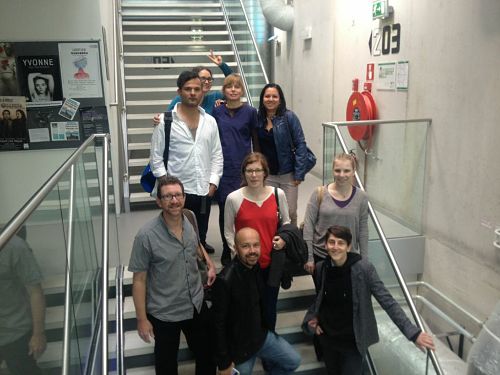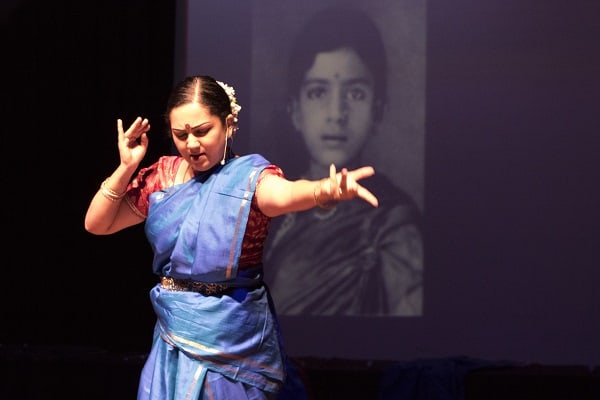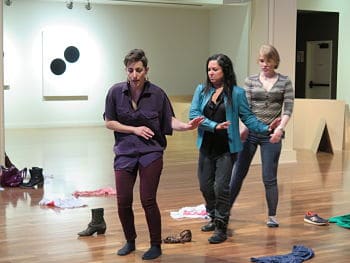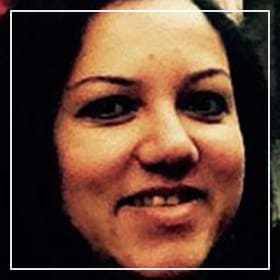It was the moment that the sociologist from University of Amsterdam Olga Sezneva announced “I will be a talking artifact” while striking a pose in the Allard Pierson Museum in Amsterdam that I knew our collaboration would work and that I was in the right place. The whole group burst into laughter and we continued our work of live performance in the museum engaging with the objects in the museum and also inserting our own objects into the exhibits. I had recently joined the Moving Matters group and was excited to bring my movement practices to the group at Susan Ossman’s invitation. Although Susan had invited me to join the group in 2013 after reading my book Sweating Saris: Indian Dance as Transnational Labor, I could not do so because I was actually “serially migrating” from California to Shanghai and then to Rotterdam. But in 2014 I joined the Motley Crue group of visual artists, scholars, writers, and performers from different parts of the world in Amsterdam at the Allard Peirson Museum of Mediterranean Antiquities.

We formed a unique bond despite our varied disciplinary backgrounds, working together long hours to experiment in forms unfamiliar to them to create what would become the final performance. A video by Blanca Casas Brullet shows us at work on “Objects in/of Migration”:
My participation in this group enhanced the work I had done as a serial migrant both in terms of my writing and performance. My previous research examines transnational Indian women migrants in the late nineteenth and twentieth century who transform the cultural and political landscape of American embodied practices through the act of performance and whose labor remains unrecognized in American histories. My performances often highlight the labor of invisible racialized migrant women through an oscillation of auto ethnography in the present and archival embodiment of various subaltern others who are differentially placed in time and hidden in the archives.

Using performance ethnography, my writing and performance work has explored the intersection of gendered migrant bodies across time and space. I was very concerned with the politics of representation. In this vein, the MMTW group also found itself discussing its own strengths and difficulties at different meeting sites. I have appreciated this self-reflexivity a great deal.
Although I performed in traditional proscenium stages, conferences, and the occasional museum, my encounter with the MMTW made me realize the importance of doing site specific performance work and particularly what a focus on collaborating between live embodied performance and visual artists and their objects might enable. When the group went to Bucharest, Natalie Zervou and I worked on Skype and zoom with multimedia elements influenced by visual artist Kayde Anobile, we presented our work fully in an online modality since we could not be there in embodied form. We found this very challenging but also rewarding to try new mediums for exchange.

In the next meeting at the Culver Arts Gallery in Riverside, Hannah Schwadron joined us as we worked internationally on a digital platform and presented a live engaged performance at the gathering involving other participants and the audience in an interactive way using structured improvisation. I found myself working increasingly in site specific spaces and each encounter with the group aided this process further.
After moving from the Netherlands to Melbourne, Australia I have done many further site specific performances and collaborated with visual artists in museums and galleries and public spaces. I’ve come to discover or re-discover generative and structural aspects of Indian dance that I use with performers working in varied movement traditions and with different levels of technical skill. You don’t have to be a dancer or know anything about dance to use this method. Here is clip from a recent workshop in Melbourne.
https://youtu.be/GVLICxJJ8-g
I look forward to preparing for “Walls” in Berlin by introducing new Berlin-based artists to the MMTW through a preparatory movement seminar using this method on June 10. This will contribute to developing movement, voice, and storytelling frameworks to the group. I will bring a classical Indian singer from Australia: Uthra Vijay, with whom I have been collaborating in Melbourne, to help set the affective dimension of the workshop. We are artists trained in classic Indian performance, but we use our forms as tools to share with those unfamiliar with the practices and stimulate them to bring their own movements, stories and sounds into the postmodern frameworks we provide. It is a true intercultural encounter that allows sharing and engagement from an embodied perspective.
I see the MMTW growing from strength to strength and look forward to the new engagement in Berlin.





